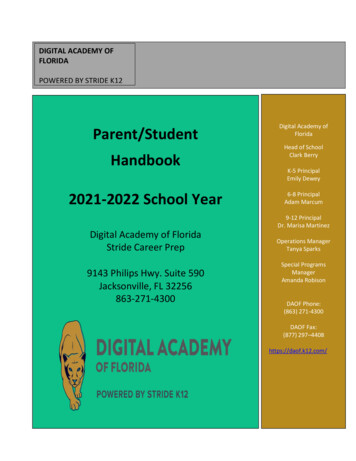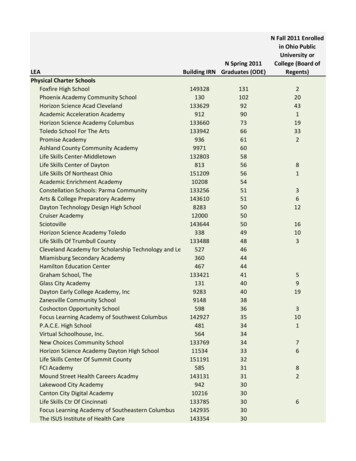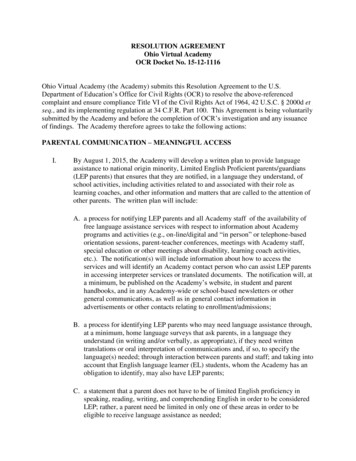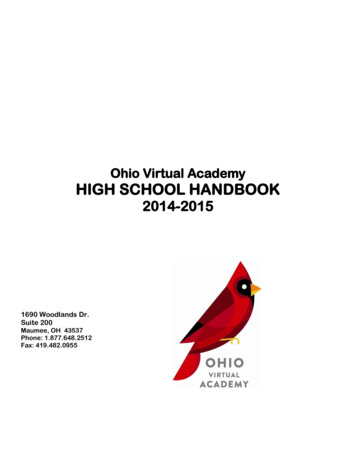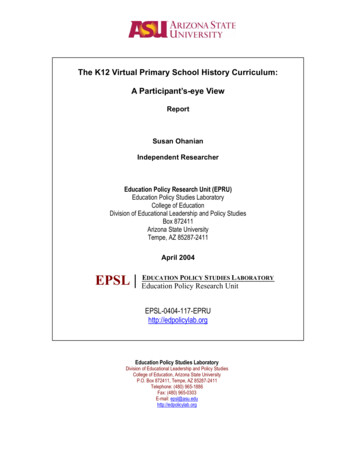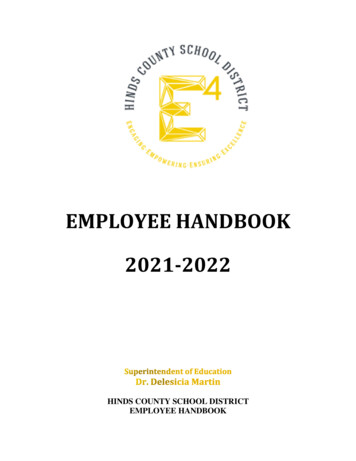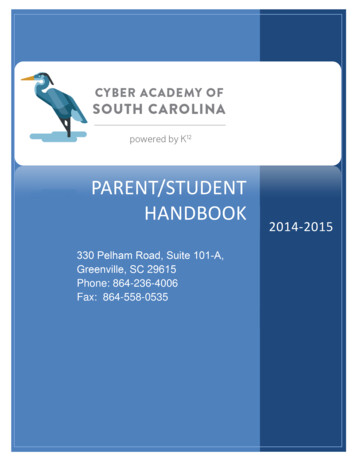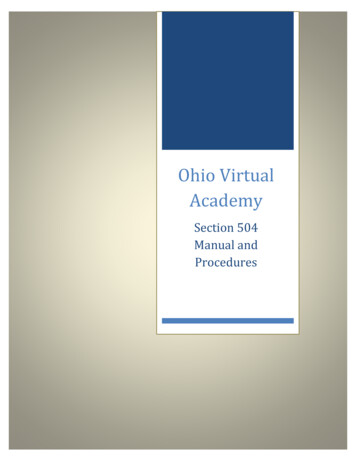
Transcription
Ohio VirtualAcademySection 504Manual andProcedures
Table of ContentsIntroduction .2Overview .3Assurances . 4Requirements . 4Identification . 4Referral . 5Evaluation . 6Section 504 Committee Meeting . 7Eligibility . 7Services . 9Discipline . 10Due Process . 11Disabled Parents. 12504 Coordinator Responsibilities. 12Section 504 Procedures . 13Appendix: Documents and Resources . 171Updated August 2019
Introduction:INTRODUCTSection 504 of the Rehabilitation Act of 1973 is federal legislation that impacts schools and otherentities that receive federal funding. The Act is a civil rights statute designed to eliminatediscrimination against individuals in schools and the workplace because of disability. Theregulations are very broadly written and intended to cover a wide range of public entities toprohibit discrimination on the basis of disability.Taken together, Section 504 and the ADA prohibit discrimination by school districts againstpersons with disabilities, including students, their parents who have disabilities, staff members,and members of the public. Included are all programs or activities of the school district receivingfederal funds, regardless of whether the specific program or activity involved is a direct recipientof those funds. There is no state or federal funding provided to help schools comply with therequirements of Section 504.Individuals who are disabled under the Individuals with Disabilities Education Improvement Act(IDEA) are also protected under Section 504/ADA. While Section 504 provides for servicessimilar to those available through special education, the intent and requirements of the acts aredifferent. IDEA is a mandate to provide special education and related services to students whomeet specific eligibility criteria for one or more of 13 categories of disability and need specialeducation and related services in order to access and make progress in the general schoolcurriculum. Section 504 provides broader and different coverage than does the IDEA with afocus on providing FAPE to all students. Section 504 also prohibits discrimination based ondisability and retaliation. If a student does not meet the eligibility requirements of IDEA but theschool district suspects that the student has a disability, the district should request consent fromthe student’s parent or guardian to evaluate the student to determine if the student qualifies underSection 504.In accordance with the record retention schedule from the State Auditor’s office, 504 documentswill be permanently retained with the school district.2Updated August 2019
Overview:There are two primary requirements under Section 504: nondiscrimination and the provision of afree and appropriate public education (FAPE). The regulations require identification, evaluation,appropriate services, and procedural safeguards.NondiscriminationDiscrimination on the basis of disability in providing any aid, benefit, or service is prohibited inany setting, including school districts.Examples of discrimination include:o Refusing to allow any student with a disability the opportunity to beon the honor roll;o Excluding a student from an academic class because the classroom isinaccessible;o Refusing to give course credit or lowering a grade for a student due tononattendance when the absences are related to a disablingcondition;o Refusing to allow any otherwise qualified student with a disability theopportunity to participate in extracurricular activities;o Refusing to provide opportunities for students with disabilities to tryout for academic or sports teams.Free and Appropriate Education (FAPE)Every student in a school must receive FAPE. This does not mean that every student receives thesame services or accommodations. Each student must be considered as an individual.What does “disability” mean?Under Section 504, a disability is any physical or mental condition that seriously limits a "majorlife activity." Major life activities include taking care of yourself, working with your hands,walking, seeing, and hearing. They also include speaking, breathing, learning, and working. Themeaning of "disability" under Section 504 is broader than the meaning of "disability" under theIndividuals with Disabilities Education Act (IDEA). For this reason, many children who are notcovered by IDEA are covered by Section 504.Assurances:Section 504 regulations concerning provision of FAPE closely mirror the procedural3Updated August 2019
requirements of special education. Students being considered for Section 504 services must bereferred, evaluated, and provided services in accordance with Section 504 regulations. Theschool has the responsibility to provide written assurance of nondiscrimination and have aSection 504 process in place. Students that are newly enrolled with Ohio Virtual Academy willhave the same rights to a 504 Plan as students that are considered current students. If the studenthas a current 504 Plan in place, the team will adopt and/or adapt the plan to fit the student’scurrent environment with OHVA.Each building must identify a Section 504 Coordinator, who works closely with the SpecialEducation Manager to assure compliance and appropriate services for all students. In all requiredSection 504 notices, the 504 Coordinator should be identified by name, address, and phonenumber.Maintenance of Records:All 504 plans will remain in a secure location with all student records as outlined by themaintenance of record policy written by the state of Ohio. PURAL REQUIREMENTProcedural Requirements:IdentificationThe identification process can be coordinated with the school’s special education child-findprocess. At least annually, however, the school must provide notice of the opportunity forreferrals in (a) school forms; (b) school publications; and (c) school handbook. Evidence of thisannual notification must be documented to ensure compliance. Students who may be disabledunder Section 504 can be referred by a concerned teacher, administrator, parent, or private/publicagency. The student may need accommodations or related services in order to receive a freeappropriate public education. Possible indicators of eligibility under Section 504 include, but arenot limited to, the following:o A parent frequently expresses concern about the student’s performance;o Retention is being considered;o Numerous suspensions occur;o A student shows a pattern of not benefiting from instruction;o A student returns to school after an accident or serious illness;o A student is found not eligible under the IDEA;o A student has a chronic health condition;o A student is in danger of dropping out of school;o A student has been identified as having ADD/ADHD4Updated August 2019
When a student has an accident, or is diagnosed with a serious illness, an immediate referral maybe made for evaluation and possible services. When instructional success is the concern, if staffsuspect that the lack of success may be the result of a disability, the student should be referredfor an evaluation. A confidential file must be created for the student where data related toremediation and intervention should be recorded. Just as with special education, the leastrestrictive service necessary to appropriately meet the student’s needs is the aim.ReferralWhen the decision is made to initiate a Section 504 referral, the parent(s) or guardian(s) must benotified. Parents should already be aware of any intervention efforts of the building-based team.A Section 504 Referral Form can be completed by the student’s teacher(s), or individualsreferring for an initial 504 evaluation, with input from others who work with the student,including the parent.When completing the form, consider the following guidelines:o Do not label the disorder. Many conditions require a medical professional fordiagnosis.o Detail the observable characteristics (e.g., the child is distracted by classroomnoises, the student refuses to comply with teacher requests 75% of the time) ratherthan labeling the characteristic (e.g., distractible, rude). This will help the teamidentify and rate the concerns listed.o Document all concerns completely and professionally. Whenever possible, statein measurable terms and provide supporting data or documentation of the concern.Once a referral is made, an evaluation must follow within 60 calendar days from parent’s consentunless there is no reasonable basis to suspect a disability. If the school elects not to evaluate areferred student, prior written notice must be provided to the parents giving them the opportunityto challenge the decision pursuant to Section 504 procedure. Section 504 Prior Written Noticeshould be modeled after IDEA’s requirements. Also, if a parent refuses to grant permission foran initial evaluation, the school may only evaluate the student by initiating a due process hearingand getting an order from an independent hearing officer.EvaluationThe evaluation for determining Section 504 eligibility is based on the type of suspecteddisability, the impact of the disability on the student's ability to participate in the school'seducational program, including nonacademic services, and the type of services oraccommodations that may be needed. There are no specific evaluation requirements for Section5Updated August 2019
504; however, the evaluation must be sufficient to accurately and completely assess the natureand extent of the disability and the impact of the disability on a specific major life activity. Thisincludes ensuring that the evaluation methods and materials are:(a) in the native language of the student;(b) nondiscriminatory; and(c) empirically appropriate to test for the suspected disabilities.Evaluations that are more limited than a full comprehensive evaluation under IDEA may besufficient. Also:a) The staff here at OHVA will evaluate, without unreasonable delay, any student suspectedof having a disability as defined by Section 504, regardless of whether the student’sparent has requested such an evaluation.b) Parents cannot be required to submit medical or other evaluation information.c) While the Academy is permitted to request medical information from the parents, if theparents do not have or refuse to provide the information, and the school determines,based on the facts and circumstances of the individual case, that a medical assessment isnecessary to make an appropriate evaluation consistent with 34 C.F.R 104.35, the schoolmust ensure that the child receives this assessment at no cost to the parents.Possible sources of existing evaluation information include, but are not limited to: Current psycho-educational evaluations Standardized achievement data Curriculum-based assessments Medical information Grades Attendance records Discipline records Teacher or parent observation notes Information from the parent/guardian, including information regardingthe student's ability to complete homework in an equivalent time period to the student'snondisabled peersBe sure that all information is current, accurate, and addresses all areas of the learning process,including adaptive behavior. It is appropriate for school personnel to make inquiries of medicaland other personnel if the information submitted is unclear. Always ask the parent to providewritten permission for an exchange of information.6Updated August 2019
Section 504 Committee Meeting:Evaluation and placement decisions must be made by a group of persons, including personsknowledgeable about the child, the meaning of the evaluation data, and the placement options.The 504 Coordinator and general education teacher should work with the parent to determine if itis appropriate for the student to attend. If the student is 18 years of age or older, he/she mustattend. When the evaluation is completed, a Section 504 meeting must be convened. Not allpersons who provided information for the evaluation and placement decisions are required to bepresent at the committee meeting. Notification of the meeting must be distributed in writing, andthe parent must receive written notice. Also, include a notice of procedural safeguards with thenotification of the meeting.The meeting should be held at an agreeable time for all. The Section 504 committee chairpersonmay have paperwork prepared in advance, but if the parent/guardian has not been provided witha meaningful opportunity to provide input prior to the meeting, paperwork may need to berevised in response to parent input. The chairperson or his/her designee should take notes. Theparent should again be offered a copy of Section 504 Parent Rights. The 504 Coordinator shouldoffer and be prepared to explain the rights to the parent. During the meeting, encourage parentsto be active participants, with opportunities to share information and express their opinions andthoughts.Eligibility:The first task of the meeting is to review the evaluation information, which includes allinformation submitted to the committee. The committee compares the information presentedwith the Section 504 definition of a person with a disability. An individual has a disability ifhe/she:1. Has a physical or mental impairment which substantially limits one or more majorlife activities. The term does not cover children primarily disadvantaged by cultural,environmental, or economic factors.o Section 504 defines physical or mental impairment as any physiological disorderor condition, cosmetic disfigurement or anatomical loss affecting one or more ofthe following body systems:(a) neurological, musculoskeletal, special sense organs, respiratoryincluding speech organs, cardiovascular, reproductive, digestive,genitor-urinary, lymphatic, and endocrine systems, or7Updated August 2019
(b) any mental or psychological disorder such as mental retardation,organic brain syndrome, emotional or mental illness, specific learningdisability.2. Has a record or history of such an impairment (e.g., a student with a learningdisability who is no longer eligible or has been misclassified to receive specialeducation under IDEA; a student in recovery from drug abuse).3. Is regarded as having such impairment. A person can be found eligible under thissection if he/she:o Has a physical or mental impairment that does not substantially limit a major lifeactivity but is treated by persons in the district as having such a limitation (e.g., astudent who has scarring or walks with a limp);o Has a physical or mental impairment that substantially limits a major life activityonly as a result of the attitudes of others toward such an impairment (e.g., astudent who is obese); oro Has no physical or mental impairment but is treated by persons in the district ashaving such impairment (e.g., a student who tests positive for HIV virus but thevirus does not substantially limit any major life activities)Note: The last two factors come into play only when there is a record or history of an impairmentwhich has resulted in discrimination. This rarely occurs in school situations.In addition to the presence of a physical or mental impairment, the condition must "substantiallylimit" one or more major life activities. This determination must be made without considerationof the ameliorative effects of mitigating measures (e.g., medication). The only exception is thatthe ameliorative effects of eyeglasses or contact lenses may be considered in determining if animpairment substantially limits a major life activity. Substantial limitation necessitates a materialeffect on one's ability to perform a major life activity as opposed to a minor limitation. Under theADA, substantial limitation is when the individual's important life activities are restricted as tothe conditions, manner, or duration under which they can be performed in comparison to mostpeople.Major life functions may include but are not limited to self-care, walking, seeing, breathing,learning, perform manual tasks, hearing, speaking, and working. When a condition does notsubstantially limit a major life activity, the student does not have a disability under Section 504and does not qualify for services under Section 504. If a student has a disability under Section8Updated August 2019
504 but does not need services in order to receive a free appropriate public education or to havean opportunity to participate in the school's educational program, including nonacademicservices, the student does not need a Section 504 plan. In such determinations, the committeemay wish to discuss possible accommodations outside the Section 504 process or refer the childfor additional support through building-based avenues.Disabling conditions may include, but are not limited to, the following:AIDS; Allergies; Asthma; ADHD; Recovering Chemical Dependency; Congenital Defects;Diabetes; Formerly Disabled; Hepatitis B; Hemophilia; Obesity; Pregnancy with MedicalProblems; Schizophrenia; Retinities-Pigmentosa; Temporary Conditions; Tourette’s Syndrome;Tuberculosis; Dwarfism; Epilepsy; Communicable Diseases.As a final note, a student must be otherwise qualified to be considered eligible for Section 504.The most common otherwise qualified factors are:(1) age; and(2) legal settlement.The student must be old or young enough to attend public school and must have legal settlementin the district to be considered otherwise qualified.Services:If the committee determines that a student is disabled, the committee must determine whatservices or accommodations are required to enable the student to receive an appropriateeducation. The Section 504 committee must determine what services and accommodations arenecessary to provide the student with FAPE and with an equal opportunity to participate innonacademic and extracurricular programs. Every case must be considered individually.Decisions concerning Section 504 eligibility must be documented in the student’s confidentialfile, and if services are provided, eligibility and the plan for services should be reviewedperiodically.The student should be reevaluated at least every three years. In addition, the committee shouldconsider reevaluation when:(a)(b)(c)(d)(e)the student transitions to a new school;the student’s behavior/academic achievement shifts;if the committee believes that the student is no longer disabled;before any significant change in placement; orthe current services are not providing FAPE and/or an equal opportunity to participatein nonacademic and extracurricular programs.9Updated August 2019
The Section 504 committee must ensure that qualified students with disabilities are evaluatedand provided access to meaningful educational services without unreasonable delay; thisincludes the development of a written 504 Plan. The plan should provide a description of thestudent’s disability. Each area of the student’s difficulty should be identified in the plan. Theplan should also include specific services or accommodations the student will receive, when theservices or accommodations will be provided and by whom, as well as how the proposed planwill be evaluated. Evaluation data must be observable and measurable.Providing accommodations also applies to parents with disabilities. The school must provideaccommodations to parents with disabilities so they are able to participate in their child’seducational program. The school must take appropriate steps to ensure that communications withparents with disabilities are as effective as communications with others.Once all accommodations are determined, the team must decide when the plan will be reviewed.Parents are asked to give consent for the identified services and should be offered explanation forany or all of the documentation.The Section 504 Coordinator is then responsible for informing all staff who work with thestudent of the services/accommodations that are required under the Section 504 Plan. It is bestpractice to have teachers and staff review the information, either in writing or verbally, andprovide written verification that indicates that they have been informed. Further, the coordinatorshould periodically check on the child and monitor the effectiveness of the Section 504 Plan. Theplan can be reviewed and/or revised at any time via the Section 504 committee. If any changesto the plan would result in a significant change in placement, the student’s parent/guardian mustbe provided with a meaningful opportunity to provide input into the placement decisions.Discipline:Section 504 requires that a school district evaluate a student believed to have a disability beforemaking an initial placement of the child and before any subsequent, significant change inplacement. The permanent exclusion of a student with a disability, the exclusion of a student foran indefinite period, or the exclusion of a student for more than 10 consecutive school days,constitutes a significant change in placement under Section 504.A series of suspensions, each of which is 10 or fewer days in duration, but that creates a patternof exclusions, may also constitute a significant change in placement. The determination ofwhether a series of suspensions creates a pattern is made on a case by case basis. Among thefactors considered in determining whether a series of suspensions has resulted in a significantchange in placement are length of each suspension, the proximity of the suspensions to oneanother, and the total amount of time the student is excluded from school. The Office for CivilRights does not consider a series of suspensions that, in the aggregate, is for 10 or fewer days tobe a significant change in placement.Before implementing a suspension or expulsion that constitutes a significant change in theplacement of a student with a disability, a school district must conduct a manifestationdetermination of the student to determine whether the misconduct in question is caused by or has10Updated August 2019
a substantial relationship to the student’s disability, and if so, whether the student’s currenteducational placement is appropriate. If it is determined that the misconduct is not caused by thestudent’s disability or the school’s inappropriate placement, the student may be excluded fromschool in the same manner as are similarly-situated students who do not have disabilities.If the parent disagrees with the manifestation determination regarding the relationship of thebehavior to the disability or with the subsequent placement proposal where the behavior isdetermined to be caused by the disability, the parent may request an impartial hearing.Due Process:Parents and students have due process rights under Section 504. These include the following: Right to be informed by the district of specific due process rights; Right for the child to be provided with FAPE and have an equal opportunity to participatein non-academic school activities; Right for the child to have an appropriate education in the least restrictive setting, whichincludes accommodations, modifications, and related services; Right to notice regarding referral, evaluation, and placement; Right for the child to have a fair evaluation conducted by knowledgeable person(s); Right to an administrative hearing and appeals process; Right to examine and obtain copies of all school records; Right to provide consent prior to evaluation or placement for Section 504 services; Right, in most cases, for the student to “stay put” during the pendency of a hearing orappeal; and Right to request an independent educational evaluation at public expense if they disagreewith the school’s evaluation.The list of rights above is non-exhaustive, but it is important to note that the crux of a parent’sdue process rights are:(a)(b)(c)(d)the right to prior written notice;the right to inspect educational records;the right to an impartial hearing to dispute a school’s decision; andthe right to appeal the impartial hearing officer’s decision.In spite of the school’s best efforts there are times when Section 504 actions lead to conflict. Thebest way to avoid conflict is to involve the parents from the beginning of the process; parentsmust be provided with a meaningful opportunity to provide input. Seek their input, document it,and be sure to consider their perspectives and requests. When conflicts arise, encourage theparent to talk with the 504 Coordinator.There is also a due process hearing option for students under Section 504. The due processhearing is intended to resolve differences involving the education of Section 504 qualifiedstudents when differences cannot be settled by means of a less formal procedure. The SpecialEducation Manager will work with the building coordinator in difficult situations.11Updated August 2019
Parents with disabilities:Providing accommodations also applies to parents with disabilities. The school mustprovide accommodations to parents with disabilities so they are able to participate in their child'seducational program. The school must take appropriate steps to ensure that communications withparents with disabilities are as effective as communications with others.504 Coordinator Responsibilities:o Coordinates district/school efforts to comply with Section 504 regulations includingtraining of administrative staff;o Consults with Special Education Manager as needed:o Establishes school 504 Team(s) and serves as chairperson;o Guides 504 referral, evaluation, and service delivery process;o Reviews 504 evaluation information if proposed accommodations require resourcesbeyond the school level;o Receives and reviews copies of all Section 504 Plans;o Maintains a master list of those students with 504 Plans, including name, grade,accommodations, annual review date, and projected reevaluation date;o Accepts and reviews Section 504 complaints, organizes and conducts investigations, andattempts to resolve any concerns or complaints;o Holds professional development annually on 504s for staff.Section 504 Procedures: Referral ParentNotification Initial Meeting Referring staff completes Section 504 Referral form.If parent is referring party, schedule initial meeting (see below)and offer Section 504 Parents’ Rights.Information gathering and a determination regarding eligibilityand placement must be completed within 60 calendar days ofthe date parental consent was received for the initial evaluation.Send Parent Notice of Section 504 Referral with completedSection 504 Referral form and Section 504 Parents’ Rights.If there is no reasonable basis to suspect a disability, the schoolmay elect not to evaluate but must provide parents prior writtennotice (include Section 504 Parents’ Rights), giving them anopportunity to challenge through an impartial hearing.Discuss the Section 504 Notice and Permission for Evaluationalong with Section 504 Parents’ Rights.Obtain permission for evaluation. If parent refuses to giveconsent to evaluate, school may, but is not required to, initiate adue process hearing. A school may only evaluate without12Updated August 2019
Evaluation InitialConference parental permission with an order from an independent hearingofficer.Ask parent to complete Section 504 Release of Information ifapplicable.Review current educational record and complete a studentrecord review.Gather or request supplemental evaluation information asneeded.Gather formal reports if necessary and request information fromprivate providers by sending Physician’s Letter andQuestionnaire Regarding Medical Concerns or Physician’sLetter and Questionnaire as applicable and include copy ofsigned Section 504 Release of Information.Use additional questionnaires to gather information from staffor parents as needed.While the Academy is permitted to request medical informationfrom the parents, if the parents do not have or refuse to providethe information, and the school determines, based on the factsand circumstances of the individual case, that a medicalassessment is necessary to make an appropriate evaluationconsistent with 34 C.F.R 104.35, the school must ensure tha
Students that are newly enrolled with Ohio Virtual Academy will have the same rights to a 504 Plan as students that are considered current students. . Section 504 notices, the 504 Coordinator should be identified by name, address, and phone number. Maintenance of Records: All 504 plans will remain in a secure location with all student records .
